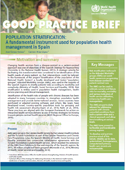Population stratification: A fundamental instrument used for population health management in Spain (2018)

Download
Changing health services from a disease-centred to a patient-centred approach was one of objectives of the Spanish Strategy for Approaching Chronicity in the National Health System (2012). A strategic priority for facilitating this transformation was considered to be identification of the health needs of every patient, so that interventions could be tailored. In the framework of the project “Stratification of the population of the National Health System”, a locally developed and tested “population grouper”, Adjusted Morbidity Groups (AMG), was used in the majority of the Spanish regions to stratify patients’ risks according to morbidity and complexity (Ministry of Health, Social Services and Equality, 2018). Risk stratifi cation is widely used in population health management, health service planning and clinical management. Stratification of the health risks of people with chronic diseases has been adopted in many European countries to strengthen population health management and provide better-tailored services. Some countries have purchased or adapted existing software, and others, like Spain, have developed novel, country-specifi c population tools for grouping and health risk assessment (Dueñas-Espín et al., 2016; Nalin et al., 2016). These practices are aligned with the European framework for action on integrated health services delivery as one of the key strategies for moving towards people-centred health services (WHO Regional Office for Europe, 2016).



